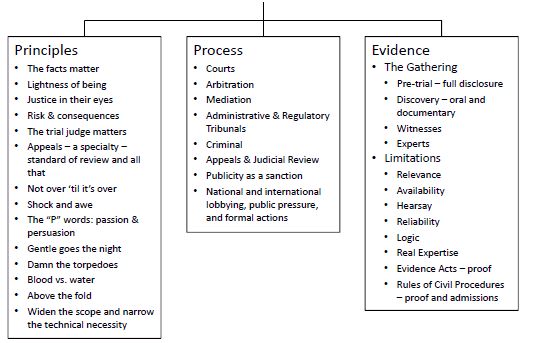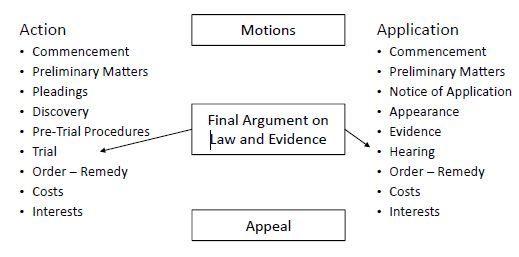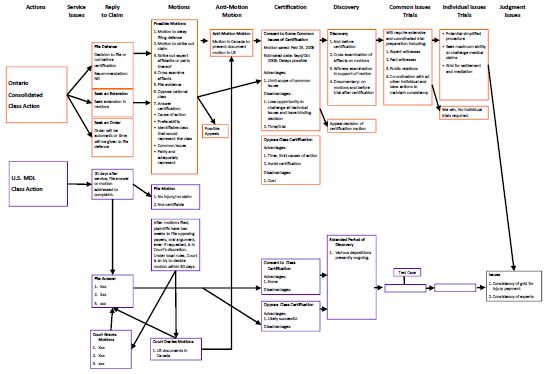Gardiner Roberts LLP are most popular:
- with Senior Company Executives, HR and Finance and Tax Executives
- with readers working within the Banking & Credit, Insurance and Healthcare industries
The Code: The Legal Mind

Process: Proof and Principles

Litigation Process ‐ The Universal Main Event

Litigation Process – Class Action

Arbitration – Process Globalization
- An existing dispute (not merely an unresolved issue);
- Parties choose neutral decision‐maker under an arbitration agreement;
- Expressed intention in the agreement that the decision be binding and be made in a judicial or quasi‐judicial manner;
- The hearing be impartial and fair;
- The decision in the hearing be based on evidence and argument;
- International arbitration (not defined in model code – see federal and provincial Acts): parties have places of business in different States when arbitration agreement is made; one of the following is outside the State where parties have places of business – place of arbitration, place for performance of obligations, place where subject matter of dispute is most closely connected; commercial arbitration acts that adopt or incorporate UNCITRAL Model Law – applicable to all provinces and federal arbitrations;
- Domestic commercial arbitration: modern provincial arbitration Acts that provide for domestic arbitration based on the model law; provisions vary significantly from province to province (contracting out, appeal rights and contracting out, procedural rules, administration of arbitration and deemed agreement provisions;
- Federal legislation: United Nations Foreign Arbitral Awards Convention Act R.S.C. 1985, C.16 (2nd Supp): Implements the New York Convention on recognition and enforceability of arbitral awards (effective May 7, 1986). New York Convention: Contracting States recognize arbitral awards; limited grounds for refusal to recognize and enforce; limited to recognition and enforcement of commercial arbitration awards made in contract in the States; 9. Guidelines: for arbitrators, awards, remedies, enforcement, legal requirements, appeals, ethics, finality.
Mediation – Process Maximizing Client's Role
- Pillars of Process: Contracting, story, interests, options, alternatives, best alternative to negotiated agreement (BATNA), agreement.
- Contracting: Engage the participants in the process of making a contract; explain the process, clarify roles and responsibilities of participants and mediator; negotiate ground rules.
- Defining the problem and dealing with conflict: understanding the conflict, the parties' view of the conflict (individual stories), working with the dynamics of the conflict; understanding the law – analyzing the legal risks and opportunities.
- Understanding interests: explore the parties' needs and interests (what matters to them going forward); generate options; evaluate options using the parties' goals, needs and interests, the law and other reference points; develop packages; test packages against parties' goals, needs and interests for stability, durability and commitment.
- Looking to the future: draft agreements; review, refine and improve upon agreements; have a concern for the unrepresented; determine next steps; implementation – provision for future review and modification.
- Identify and control: drama, narrative, identity and emotion.
- Trust in the mediation and commitment to trust for future action.
- Imperfections: dysfunctional communication and emotion; asymmetries of information; extreme "partisan perception" bias; disrespect (real or perceived); failure to understand others' views, or care; strong desire for revenge or vindication; agreement has unpalpable meaning.
- Process variance: preliminary work (pre‐planned, a formal evaluation phase, mediate discovery, caucuses single‐text model.
Mediation Made Simpler
Variable Five Stage© Resolution Process to early and later stage dispute assessment, strategy, risk audit assessment, mediation, arbitration, litigation and resolution.
- Stage 1 – Setting the base for success – trust, creativity and tailoring the process, mediation/arbitration agreements, desire/pressure to resolve.
- Stage 2 – the gathering – facts, chronology, analysis, explanations, documents and data and compiling all in a common independent programme developed on consent.
- Stage 3 – process selection – interchange, combinations and switching: managed direct settlement negotiation or offer exchange (online or face to face), mediation, arbitration.
- Stage 4 – expert advice – area of dispute (large corporate, closely held enterprise, estates, on‐going relationships) psychological factors, settlement design, tax implications, media, regulatory and government relations.
- Stage 5 – philosophy – settle what is known through identifying and prioritizing legal issues and actual interests; have a process to deal with future issues if and when they arise through negotiation or arbitration.
Process – Regulatory & Criminal: Ceding Control
Strategy – Psychology 101
| Business Corporations | Securities |
| Energy | Office of the Children's Guardian |
| Public Trustee | Labour |
| Real Estate & Business Brokers | Criminal Code |
| Tax | Insurance |
| Broadcasting | Transportation |
| Professional Complaint: Self‐regulating professions | Lawyers |
| Doctors | Nurses |
| Accountants | Other |
- LAMS: Litigation, arbitration, mediation, settlement
- Analysis and process – combine in a complex interaction, depending on realistic goals, timing, financial, psychological and other limitations, advantages and disadvantages
- Impacts inside legal system –
"In" Factors
- Corporate
- Directors
- Public – negative
- Securities – disclosure
- Professional status
- Criminal act and recovery
- Outside legal system –
"Out" Factors
- Business and political impact
- Publicity as a tool and a
sanction
- Resources of parties
- Financial
- psychological
The content of this article is intended to provide a general guide to the subject matter. Specialist advice should be sought about your specific circumstances.


